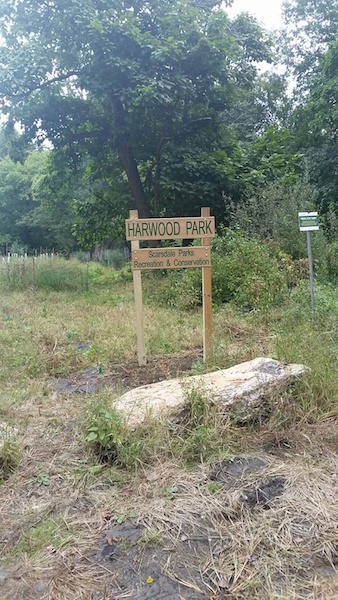Harwood Park is Reborn
- Details
- Written by Dan Hochvert
- Hits: 4980
 Beginning in 2014 the Friends of the Scarsdale Parks (FOSP) embarked on an ambitious reclamation of several acres in the heart of the village. Designated as Harwood Park in 1928 in honor of Scarsdale's first planner, the parkland languished for many years without care until FOSP got to work on a comprehensive environmental restoration – after obtaining a grant from New York State Department of Environmental Conservation's Trees for Tributaries program.
Beginning in 2014 the Friends of the Scarsdale Parks (FOSP) embarked on an ambitious reclamation of several acres in the heart of the village. Designated as Harwood Park in 1928 in honor of Scarsdale's first planner, the parkland languished for many years without care until FOSP got to work on a comprehensive environmental restoration – after obtaining a grant from New York State Department of Environmental Conservation's Trees for Tributaries program.
The park is situated on the Bronx River watershed west of the South Fox Meadow Brook, between the Library and the High School gravel parking lot (off Brewster Road). To prepare the ground for planting a large undeveloped section of the park was assessed by a team of FOSP board members, the village Department of Public Works, and the Parks, Recreation and Conservation Department. Before beginning more intensive work, the DPW members of the team cut an access path from the gravel parking lot to the library. The next step involved removal of debris, pieces of concrete and discarded road signs.
A front loader leveled parts of the area and removed some of the invasive plants such as Japanese knotweed and mugwort. Then further hand digging and cutting was needed to remove the more deeply rooted and stubborn "invaders" to set the stage for the community "Big Planting" in early May 2015. As a prelude to the event, members of FOSP pruned three foot un-rooted twigs from the grove of pussy willow trees in the meadow adjacent to the Library Pond gazebo. Then they dug about thirty 18 inch holes along the western edge of the brook and planted the cuttings. Some of those little twigs have since grown into new 15 foot trees along the stream bank.
Scarsdale's historic, first Community Planting Day was inaugurated on a beautiful Saturday co-sponsored by FOSP and the village. About 150 volunteers of all ages assembled to plant almost 300 native trees and shrubs provided under the grant by the DEC. Beth Roessler, the DEC's regional coordinator who delivered the plants, protective tree sleeves, black weed mats and stakes, gave instructions and the community went to work. Volunteers included the mayor and village trustees, Brownie and Girl Scouts, Boy and Cub Scouts, High School students, members of civic organizations such as the Rotary Club and Scarsdale Forum, and numerous residents accompanied by their children and friends. Before the end of the day, about an acre full of plants began their new life in Harwood Park.
When rain failed to materialize in the first two weeks after planting day, FOSP bought a battery operated pump to enable members of its board to take turns irrigating the new plants, using the brook as the water source. During the ensuing year, a weed whacking attack on invasive plants kept them in check, and FOSP donated and planted another dozen carefully selected native trees. Today, about ninety percent of the 2015 plants have happily thrived and transformed that section of Harwood Park.
Before last winter, the village had a contractor de-silt a major section of the brook alongside the gravel parking lot. The silt was left in the park until early this spring, when the contractor returned to spread the rich silt over a large open field west of the 2015 planting area. The soil on this freshwater wetland floodplain has been ideal for most of the plants, which continue to be cared for by FOSP. By May 2016 the DEC had again provided about 250 native trees and shrubs, and another diligent group of community volunteers continued the restoration in the area between the 2015 planting and Brewster Road. They represented most of the same groups that participated the previous year, and were joined by members of the Bronx River Reservation Conservancy. Today it is rewarding to see High School students and neighbors walking and biking along the path through a restored Harwood Park, where students and their teachers are studying nature, birds are building nests in the newly planted trees and a wide variety of native plants are helping to create a more balanced ecosystem.
FOSP is in the process of planning for a third planting at Harwood Park in spring 2017 that will reforest the floodplain along Brewster Road, enlarge the planting area on the western side of the brook, and establish a beachhead on the easterly bank as part of the ongoing effort to eradicate invasive plants at the edge of that woodland. Anyone who wants to know more about this project and participation in other community restoration work is welcome to contact the authors Madelaine at meppenstein@eppenstein.com or Dan at danghochvert@gmail.com.
Village to Credit 1600 Water Users for Excess Water Usage
- Details
- Written by Joanne Wallenstein
- Hits: 9402
 To those concerned about high water bills from the summer, Village Manager Steve Pappalardo announced that the Village needs to adjust the bills of about one third of Scarsdale's water users. A miscalculation for excess water charges for the summer months caused the Village to overcharge1,600 customers for excess water used during the billing period. The Village rechecked high volume accounts and found that additional water units from the tail end of the period were billed at excess rates. The 1,600 customers who exceeded 50 units with program use read dates of 100 days or more will each receive an average credit of $130, depending on usage.
To those concerned about high water bills from the summer, Village Manager Steve Pappalardo announced that the Village needs to adjust the bills of about one third of Scarsdale's water users. A miscalculation for excess water charges for the summer months caused the Village to overcharge1,600 customers for excess water used during the billing period. The Village rechecked high volume accounts and found that additional water units from the tail end of the period were billed at excess rates. The 1,600 customers who exceeded 50 units with program use read dates of 100 days or more will each receive an average credit of $130, depending on usage.
To find out if you qualify for a credit, click here. You will need your water bill in hand to look up your account number.
The Village will adjust the residents' online accounts. If you have questions, call Village Hall at 722-1172 or email the treasurer's office at treasurer@scarsdale.com. Listen to a full explanation from Village Manager Steve Pappalardo here.
Pappalardo also spoke about upward pressure on water rates from New York City and encouraged residents to do everything they could to conserve water. He said that Scarsdale is among the highest per capita users of water of all water customers served by the City of New York and recommended that residents do the following to monitor and decrease usage:
- Check your water meter
- Buy web-based tools to regulate and monitor consumption
- Purchase low-flow plumbing fixtures
- Use aerators on faucets
- Check for leaks in your irrigation system
- Reduce lawn watering
- Replace lawn with native plantings
- Use leaf mulching and grass cycling to maintain moisture
Scarsdale Volunteer Ambulance Corps
David Raizen who leads the Scarsdale Volunteer Ambulance Corps (SVAC) made an appeal to residents to donate funds to support SVAC who makes 1,500 calls a year and is not supported by tax dollars. They recently mailed out an annual fund drive and report little response. Their goal is to raise $250,000 and to date they have only received $75,000, which is not enough to support the service for the coming year.
Food Scrap Composting
Trustee Deb Pekarek introduced a resolution to facilitate the collection of food scraps at the Recycling Center on Secor Road for composting and to create an ad hoc committee to oversee the program and to educate the public on using it. The resolution authorizes the placement of receptacles to collect food scraps at the recycling center that will be picked up by a commercial hauler on a weekly basis and brought to a composting facility. The program would allow residents to recycle meat, fish, dairy, bread, rice, pasta, oil bones and shells which are difficult to compost at home.
The ad hoc committee will include Ron Schulhof, Michelle Sterling, DPW Superintendent Benedict Salanitro and Sanitation Foreman Stephen Arangio. The resolution was passed unanimously by the Board of Trustees.
Parking at Hyatt Field
In other news, Trustee Matt Callaghan reported that the Parks and Recreation Council opposes the construction of a 27-space parking lot at Hyatt Field. In order to regulate parking and traffic near the park, they did support no-parking signs on the eastern side of Potter Road and the northern side of Lee Road as well as the construction of three additional spaces on Boulevard. They also supported the widening of Potter Road by three feet to allow emergency vehicles ample space. No parking lot will be built at the field.
that the Parks and Recreation Council opposes the construction of a 27-space parking lot at Hyatt Field. In order to regulate parking and traffic near the park, they did support no-parking signs on the eastern side of Potter Road and the northern side of Lee Road as well as the construction of three additional spaces on Boulevard. They also supported the widening of Potter Road by three feet to allow emergency vehicles ample space. No parking lot will be built at the field.
Library:
Trustee Jane Veron reported that the trustees visited libraries in Darien, CT and Mamaroneck, NY and met with librarians to discuss public/private partnerships and building libraries for the future. A meeting to consider a possible referendum on the renovation of the library will be held on November 29 at 6:55 pm at Village Hall.
Mayor Provides Extensive Answers to Questions About the 2016 Revaluation
- Details
- Written by Joanne Wallenstein
- Hits: 6495
Scarsdale Mayor Jon Mark continued to address the 2016 revaluation at the 10-25 meeting of the Scarsdale Board of Trustees
Here are his comments:
From Scarsdale Mayor Jonathan Mark:
On October 14, 2016, we received two emails from Mayra Kirkendall-Rodriguez prompted by the Committee of the Whole meeting on October 13, 2016, which was held to consider whether or not to take steps to phase in certain assessment increases resulting from the 2016 revaluation for a limited number of certain eligible residents. That question was taken under advisement and will be considered further this evening.
In summary, the emails received asked the following questions:
1. What precedents and statutes prohibit the Board of Trustees from invalidating the 2016 revaluation?
2. Have any of you spoken to any counsel other than the Village Attorney?
3. Why was Tyler not given a chance to do the 2016 revaluation? Were Trustees aware that Tyler sent a proposal to the Assessor?
4. Can State Assemblywoman Amy Paulin be asked to introduce emergency legislation to invalidate the 2016 revaluation?
5. Who at the NYS Office of Real Property Tax Services (ORPTS) did we speak with on this subject?
6. When will an ad hoc committee on revaluation be convened? How will its members be selected? Will it be up to residents to volunteer?
I responded to the emails noting that I would address the questions in my comments tonight. Here is my response.
1. The legal framework in which the Board is operating was summarized in a 1972 opinion of counsel of the State Board of Equalization Assessment (SBEA) issued March 13, 1972 (Volume 1 – Opinions of Counsel SBEA No. 75). The SBEA was the predecessor to the ORPTS. The question presented was "whether a town board has the authority to prohibit the assessor from using a reappraisal the board considers unsatisfactory and to direct the assessor to use a prior roll as the basis for the current assessment roll to be completed." The Opinion reviews relevant statutory provisions. It cites Section 2 of Article 16 of the Constitution of the State of New York noting that it provides, in part, that the Legislature shall provide for the supervision, review and equalization of assessments for purposes of taxation. The opinion then states that the State Legislature has delegated the exclusive authority to assess real property for the purposes of local real property taxation to local assessors (citing, Town Law, section 33 and Real Property Tax Law, section 500 et. seq.). The opinion concludes that: "The town board, therefore, has no authority to substitute its judgment for that of the assessor and the exclusive remedy available to a property owner, who considers himself aggrieved by reason of any assessment made by the assessor, is that which is provided by Article 5 and Article 7 of the Real Property Tax Law." Article 5 is the provision that establishes the Board of Assessment review grievance process. Article 7 establishes the process for judicial review of assessments through SCAR filings and certiorari petitions. The counsel to the SBEA issued an opinion stating the same conclusion on July 3, 1975 and again by way of update on February 10, 2012 (Volume 2 – Opinions of Counsel SBEA No. 29).
2. No subsequent interpretation, regulation or case that asserts a contrary view has been brought to our attention and therefore these opinions appear to state a definitive view of the law.
3. Last month we had a telephone call on this subject with Assemblywoman Amy Paulin and members of the ORPTS Staff. Included in that call was Amanda Hiller, the Deputy Commissioner and Counsel of ORPTS. She confirmed our understanding of the legal limits on this Board's authority as set forth in the SBEA (the predecessor to ORPTS) opinions. So in terms of speaking with counsel other than the Village Attorney, the answer is yes, we have spoken with other counsel who is conversant with the relevant regulatory scheme and so is an authoritative source for the purpose of confirming what our own research has shown.
4. In terms of whether or not the Board knew of Tyler's interest in doing the follow-up revaluation, I have not seen evidence that it did. However, given the level of resident criticism of the work Tyler did in 2014 it would have been an unlikely choice at the time to do a follow-up revaluation. By analogy, that would have been tantamount to asking J. F. Ryan to do the next revaluation. However, whether the prior Board knew of Tyler's interest or not, it is reasonably clear that at least a part of the answer to the question on why J.F. Ryan was chosen to do a revaluation in the manner it was done seems to have been based on budgetary considerations and the goal sought to be achieved by the 2016 revaluation. As we all now know, the 2016 revaluation was prompted in large part by the criticism of some residents of flaws they perceived and analyzed in the Tyler revaluation. It was hoped that a further revaluation would improve on what Tyler had done. In seeking to do so, budget concerns played a part in seeking a means for achieving that objective at a lower cost than the just under $1 million spent on the Tyler revaluation. It was believed that could be accomplished because the subsequent revaluation would utilize – and did utilize -- all of the property data collected by interior inspections made by Tyler of virtually all properties located in the Village. Having had an unprecedented 95% participation rate by residents in granting access to their homes to collect that data, it was believed that by using that current data, a subsequent revaluation would not have to involve access to residents homes and substantial savings could be achieved. In fact, ORPTS, in accordance with its Cyclical Reassessment Aid Program, requires all parcels to be "physically inspected" once every six years. This type of physical inspection does not necessarily require the kind of comprehensive Village-wide interior data collection completed by Tyler for the 2014 revaluation. The generally accepted industry standard for completing such a comprehensive interior inspection is no less than once every 10 years but certainly not two years after such an effort was accomplished.
5. As far as asking Assemblywoman Paulin to introduce legislation providing authority to invalidate the 2016 revaluation, whether or not such a request should be made is a matter with which members of this Board have wrestled. The issue is not whether we can make that request or not – any request can be made and Assemblywoman Paulin has always been supportive of Scarsdale. We have confirmed this point with her.
I have also had a similar conversation with State Senator Andrea Stewart-Cousins who also said that she would do what she could to be supportive of the Village.
However, the threshold question before us is not whether we can make such a request, but rather if we did and even if it were granted would that be the best result for the Village as a whole. It is on this threshold question that I have a different view from those residents who have urged us to make such a request. I believe that even if the final 2015 assessment roll could be reinstated, that would not be the best result, have stated so previously and will repeat some of what I have said before on this subject.
For members of this Board who were on the Board at the time of the Tyler revaluation the similarity of the circumstances we face today with respect to the 2016 revaluation are several in important respects. There is a strong dissatisfaction with the results of the 2016 revaluation. The same was true in the case of the 2014 Tyler revaluation. There is a call to do another revaluation as soon as possible. The same was true in 2014. The two scenarios differ in those who are voicing these sorts of concerns, but the calls to action are essentially the same: the product is flawed, let's throw it out and redo it.
As I have said before, in my view replacing the 2016 revaluation which has been criticized for its flaws, with the results of the 2014 revaluation that were subject to similarly vehement criticism, does not address the issue at hand. This not a question of the Board being afraid to anger some residents. This Board has shown in the past year and a half that it does not shrink from exercising what it believes to be a reasonable judgment just because it might make some residents angry. So too in this situation, as the Board considers the issues before it one thing is clear, that probably any decision made by the Board will make some folks unhappy. That is simply the nature of the circumstances in which we find ourselves. As I have said previously, reinstating the prior assessment roll, with the flaws inherent in it, will undoubtedly precipitate a host of issues – some that might be anticipated and some unforeseen. Several sorts of legal and practical issues may arise.
• A legal issue that re-instatement would trigger is that those who may be grieved by the reinstatement of the 2015 roll would be denied an opportunity to file grievances. That inability must be seriously considered. A course of action that fails to afford residents their due process grievance rights would be an egregious result -- not simply a matter of angry residents. In contrast, those homeowners aggrieved by the 2016 roll were afforded the opportunity for – and did pursue administrative and judicial relief from the assessments through the statutory grievance process.
• During the period such legislation was working its way through the legislative process a period of months of uncertainty over assessed values in the Village would continue, with no promise of what the resolution would be. The legislative process would require action by each of the State Assembly and the State Senate and then action by the Governor. The formal legislative process could not start until January 2017 when the legislators go back in session. We have also heard that it is sometimes the case that individual legislators from one locality will withhold voting on legislation focused on another locality until the end of the legislative term in June. They use their vote as a negotiating tool for getting votes on measures they are sponsoring. What this means is that just because our representatives may support legislation we might request, passage could involve a very prolonged period during which the process plays out with little certainty as to the result. This sort of extended period of uncertainty would do little to ease the angst some have experienced as a result of the 2016 revaluation and if the legislation did not get adopted, would not address it at all.
• As a practical matter, if authorizing legislation was passed, implementation would likely not be feasible until deep into 2017 either concurrent with the time for issuance of initial tax bills – or even after initial tax bills went out based on the 2016 valuations still in place. This would create a chaotic scenario in the administration of taxes on the County and local level increasing the possibility of incorrect billings, the need to issue refunds and additional tax bills. Such a scenario would be another source of distress for residents that cannot be dismissed.
• Lastly, reinstating the 2015 roll does not squarely address the problem now confronting us, making pursuing this course undesirable in my view.
The framework provided by statute for dealing with the effects of a Village-wide revaluation are in process. 1,103 of our homeowners availed themselves of the administrative appeal to the Board of Assessment Review and based on data provided to me today, of those, 584 have filed for further review of their grievances either by way of SCAR proceedings (463) or Cert petitions (121). Any assessment reductions granted these property owners will automatically cause a redistribution of property taxes to the other property owners who did not grieve.
The point is that to address the present concerns of the residents who have spoken up, the path forward is to do another Village-wide revaluation – and do it in a well thought-out, well publicized and inclusive manner that is adequately documented and understood – even if there are some that may disagree with whatever its outcome may be.
Moving forward: process for considering future revaluation: So when and how do we go about doing another re-valuation. Once we carefully map out the "how" process, the "when" can be determined. In terms of the "how" we have asked the Village staff to draft an outline of a revaluation process that reflects what we have all learned from the 2014 and 2016 processes. The high points are fairly straight forward: locating a pool of qualified and available vendors and selecting a vendor through a suitable vetting process; drafting a clear and manageable professional services agreement including a detailed scope of work, achievable milestones and the necessary deliverables; oversight of the process in a manner that assures what has been contracted for is actually performed and delivered; allowance of a period in which residents can informally ask questions about preliminary assessment results and in which appropriate corrections can be made prior to the tentative assessment roll statutory filing date; and budgetary considerations.
We have commented that the process for considering a future revaluation should be a thoughtful one that included, among other things, resident input. In that regard, we had spoken generally about forming an ad hoc advisory committee of residents, with Village staff representation, for that purpose.
To that end, we are considering what the make-up of the Committee should be, taking into account the suggestions we have received from residents in that regard.
We will need to flesh out the mandate for the ad hoc committee but in general terms, it would be a vehicle for making recommendations to the Village Board and the Village staff on the process for the next revaluation; for providing input on the selection of a firm to do the work; and providing some level of oversight of the process, consistent with any legal or conflict of interest limitations. The scope of these roles will have to be thought out further, but it is not contemplated that the ad hoc committee would do the work or otherwise be involved in the conduct of the revaluation itself. It would be important for all residents to know that the execution of the revaluation will be, and was, in the hands of whatever vendor was engaged for the purpose and Village staff – and was not subject to the control of a select – albeit well-meaning – group of residents. The process of appointing this sort of ad hoc committee will be advanced in the coming months and we will let residents know when we are ready to start accepting applications.
Water Bill Go Up? Here's Why
- Details
- Written by Joanne Wallenstein
- Hits: 6407
 Several people have noted that their water bill was much higher than usual this year. The most recent bills were for summer usage; mine covered June 6 to September 13 and includes the bill for the water we used to keep our lawn green.
Several people have noted that their water bill was much higher than usual this year. The most recent bills were for summer usage; mine covered June 6 to September 13 and includes the bill for the water we used to keep our lawn green.
The Village purchases water from New York City who charges us separate rates for regular and excess water usage. It was previously explained to me that usage is allocated by population numbers and that each household in Scarsdale is allocated about the same amount of water that would be used by a family of four in an apartment in the city. Any usage above that is deemed "excess," and billed at $8.75 per unit, roughly 3.5 times more than the regular rate of $2.50 per unit.
The bills seem higher because they actually have increased. According to Scarsdale's Water Superintendent Stephen Johnson unit rates went up from $2.05 to $2.50 in April 2016, and this is the first bill for residents that is calculated with this rate. A unit is 100 cubic feet of water, or 748 gallons. Johnson also noted that it was one of the hottest, driest summers on record, which caused residents to use even more water to keep their lawns and plantings green.
Also in order to replace the aging sewer system in Scarsdale, the Village now assesses residents a "Sanitary Sewer Rent Fee" which is assessed at .65 cents per unit of water consumed.
According to Johnson, the best way to reduce this bill in the future is to calibrate your sprinkler system correctly and to check your sprinkler system for broken heads or leaks. Johnson also suggested you install a rain gage on your sprinkler system so that it does not go on when it's raining.
Board of Trustees Explores Possible Real Estate Tax Phase-In For Hardest Hit Residents
- Details
- Written by Joanne Wallenstein
- Hits: 5021
 Should people who received more than a 25% increase in their real estate taxes after the 2016 revaluation be granted some relief? That's what the Scarsdale Board of Trustees discussed at a special meeting on Thursday night October 13. Under consideration was the possibility of asking the state legislator to consider special legislation to allow residents who received greater than a 25% increase, are STAR eligible and meet certain other criteria to be allowed to phase in their tax increase over a period of three years. During that three-year period, the balance of taxpayers would pay more in taxes to make up for the shortfall from their neighbor's savings.
Should people who received more than a 25% increase in their real estate taxes after the 2016 revaluation be granted some relief? That's what the Scarsdale Board of Trustees discussed at a special meeting on Thursday night October 13. Under consideration was the possibility of asking the state legislator to consider special legislation to allow residents who received greater than a 25% increase, are STAR eligible and meet certain other criteria to be allowed to phase in their tax increase over a period of three years. During that three-year period, the balance of taxpayers would pay more in taxes to make up for the shortfall from their neighbor's savings.
Deputy Village Manager Robert Cole reviewed a study done by Village Managers to examine how many residents might be eligible and what the effect of the phase in program would be on the balance of taxpayers.
The study estimated that only 128 homeowners would potentially be eligible – and that assumes that these people did not grieve their over the summer, bringing their tax increase below 25%. To qualify, they also need to be up to date on their taxes and to not have done a renovation that is responsible for their tax increase. Last, they would need to file their paperwork on time.
Cole presented data to show the estimated tax increase that the balance of taxpayers would have to pay to subsidize the loss in revenue from the phase in if 128 residents qualified. He estimated these increases for homeowners with homes at varying values.
- If you own a house that is assessed at $629,000, you would pay $38 more in year one and $19 more in year two.
- If you own a home valued at $1,500,000, the increase would be $92 in year one and $46.40 in year two.
- For a home valued at $3.5 million, taxes would increase $214 for the first year and $107 for the second year.
If the Board did decide to move forward, it would need to pass both houses of the NYS legislature, be signed into law by the Governor and there would be ample time for public hearings. It would be put into effect in March before the following year's tax roll was filed with the state.
Commenting on the proposal, several people at the meeting asked why the Village would go to all this work to benefit fewer than 128 people. Others asked the Village to use their energy to invalidate the 2016 revaluation, rather than attempt to ameliorate its effects.
Mayra Kirkendall Rodriguez said, "Given that this will take an enormous amount of village resources and time for people on the Board of Trustees, why would you spend political capital in this manner and not ask the legislature to invalidate the entire revaluation?"
Mayor Mark explained, "This was done to help those who were most seriously impacted by the revaluation. We know that this has past muster with the Governor. It is unprecedented to invalidate the revaluation. In fact, the Governor vetoed legislation to invalidate a reval due to objections from the county."
He added, "The Tyler reval was criticized as well. If we went back to the 2014 revaluation, there would be an equal number of people who were unhappy with that result. That is not a practical way to address this issue."
Mark said that the Scarsdale Forum was studying the revaluation and that perhaps the League of Women Voters and an ad hoc committee would also be assigned to look into the best way to do the next revaluation. He said, "That's where we should focus our energy."
Robert Berg said, "I believe the phase in is a bad idea. I object to any legislation favoring any one group of taxpayers. It is inappropriate and unprincipled. I think the number of eligible parcels is less than 128. What about those who filed grievances? Some may have filed SCARS? There might only be 20 eligible properties. It is ridiculous for legislation to be passed by the state for a very small number of residents. It does not make sense to use our pull with Albany to do this. Let's get approval from the state to allow Scarsdale to void this revaluation. I am serving on the Forum committee on the revaluation and I think our committee will ultimately say we need to do a new revaluation using the Tyler methodology."
Village Manager Steve Pappalardo responded to Berg, indicating that the Village needed more time before implementing yet another revaluation. He said, "We have found that revaluations that went well had a tremendous amount of community outreach before and during the process. It is also good to give the residents their assessments early and let them have the chance to meet with the vendor. We have learned a lot – and we don't want to make those same mistakes again. The community is going to need be informed. It probably will not be done for 2017... and will take until 2018."
Sherry Berkowitz of Ross Road said, "My assessment went up 40% Why will this work only for people who are STAR eligible?"
You can watch the meeting on Scarsdale Public TV here:
After the meeting, the Board of Trustees held their regular meeting and Mayor Jon Mark offered comments on the phase-in and the equalization rate, which the NYS Office of Real Property Tax Services (ORPTS) has determined to be 89.14. The Village considered challenging this rate, but a consultant analyzed the data and determined that his calculation would be the same as ORPTS and did not recommend a challenge.
Read the full text of the Mayor's remarks below:
Comments by Jon Mark
Meeting of Board of Trustees
October 13, 2016
2016 Revaluation Related Matters Update
I provided an update on 2016 revaluation related matters as part of my State of the Village address at the Scarsdale Forum meeting last Thursday. What follows is an updated version of those comments.
• The possibility of seeking legislation to permit a three-year phase-in of increases in assessments experienced by certain residents on whom the impact of the revaluation was sufficiently harsh as to put them in jeopardy of leaving the Village was considered at a Committee of the Whole meeting held this evening just prior to this meeting. The pros and cons of pursuing that course of action were discussed, we listened to public comment on the proposal and the Board has taken the matter under advisement. To repeat comments made at prior meetings, any New York State legislation that would authorize the Village to adopt a phase-in Village Code provision would have to be approved by both houses of the State legislature and be signed into law by the Governor. If those events occurred, the matter would be back in the hands of the Village Board. At that stage, the Board would have to consider, at a public hearing, whether to adopt a Village Code provision that would put the phase-in into effect. Since the State legislature is not scheduled to re-convene until January 2017, it will be some months and several procedural steps before a phase-in Village Code provision is adopted, if it is adopted at all.
• The Village staff continues to collect and organize information that might support a claim against J.F. Ryan & Associates. In the meantime, the Village continues to withhold from J.F. Ryan approximately $49,000 in fees he claims are due his firm.
• This week the Village received notice from the NYS Office of Real Property Tax Services (ORPTS) that a tentative state equalization rate for the Town of Scarsdale of 89.14 had been established. This rate is minimally higher than the preliminary equalization rate of 89.06 issued by ORPTS on September 7, 2016. Soon after receiving the preliminary rate, the Village staff explored the possibility of contesting the preliminary state equalization rate issued by ORPTS and retained a consultant to assist with that effort. The consultant completed his analysis and submitted to it to ORPTS for review. After consulting with ORPTS regarding his work, the parties agreed that the consultant failed to undertake certain statistical procedures used by ORPTS in its analysis to make an adjustment in the sales ratio analysis data. The consultant then reviewed his work further and concluded that based on the parameters of ORPTS' approach, his calculation would be approximately the same as theirs. The Village Manager convinced the consultant to waive any payment for his work in light of this outcome.
Based on the review of the preliminary equalization rate through the Assessor and the consultant, and subsequent discussions with ORPTS, it is highly unlikely that any new information will be available to persuade ORPTS at an administrative hearing to increase the equalization rate substantially. It is therefore unlikely that further proceedings with regard to the equalization rate will be pursued. However, this may help to support our claim against J.F. Ryan relative to the quality of his work. The Village Attorney has incorporated this information into the bill of particulars he has drafted for this purpose and sent to J.F. Ryan's counsel.
• Regarding the question of whether the Village Board will take steps to void the 2016 revaluation, as has been stated at past meetings, the Village Board does not have statutory authority to take such an action on its own. We understand that should the Village wish to pursue this route, the earliest draft legislation could be submitted for initial consideration in Albany would be January 2017. Based on that timing, it is not likely we would learn whether or not the legislation passed for several months thereafter, close to the time the spring tax bills had to go out. Further, based on the report of the 2011 experience of the Town of Hamilton, New York when it sought legislation to simply extend the filing date of its assessment roll, it is possible that Westchester County might oppose any such legislative proposal as did Madison County in the case of Hamilton. That opposition proved persuasive in Hamilton's case and the Governor vetoed the legislation despite it having passed in both houses of the New York legislature. It is reasonably apparent that a request to entirely void an assessment roll – as contrasted with a request to simply extend a filing date which was Hamilton's request -- would be a more difficult issue for Albany to approve.
• We recognize residents' issues with the 2016 revaluation and the strong desire of some to reinstate the 2015 final assessment roll. However, it is less than clear that reinstating the 2015 final assessment roll, and it is not clear that that could be done, would be a prudent course to take since that roll too had its critics. One procedural issue that re-instatement might trigger is that those who may be grieved by the reinstatement of the 2015 roll would not have an opportunity file grievances. That inability must be seriously considered. It is my view that rather than reinstating a prior roll that also had its flaws and so could precipitate a host of additional issues, the Village as a whole would be better served by looking ahead and planning in a thoughtful way for the next Village-wide revaluation. If the Village were to adopt the phase-in approach just mentioned, those who felt the greatest burden of the 2016 revaluation and were in the least favorable position to bear that burden, would get some measure of relief (admittedly allocated to all other residents). In the case of the Towns of Greenburgh and Ossining, both of which adopted the phase-in approach, that approach was sufficiently bearable by all residents as to make it worthwhile. However, as has been stated previously, no decision has been made whether to implement a phase-in as described.
• With respect to the Assessor and the Assessor's Office, the Board is studying what should be done within applicable legal parameters about the staffing and functioning of that office.
Timing of SCARS Filings
The Staff has informed me that because the statutory filing deadline for the SCAR appeals of October 15, 2016 falls on a weekend, the filing deadline is extended to the next business day, which in this case, is Monday, October 17, 2016. This will allow homeowners the weekend and another business day to finalize their SCAR appeals.
Hyatt Field Parking Issues
The Parks and Recreation Department had been discussing with certain residents who live directly adjacent to Hyatt Field means for reducing the in-street traffic issues that are being exacerbated by the popularity of the new playground at Hyatt Field. The Village staff had been receiving complaints that residents could not get out of their driveways at times, due to the amount of additional traffic parked on their streets. In order to address that issue, Parks & Rec revived a plan that had been discussed in prior years to pave a driveway ingress at the border of the field and create a parking lot that would allow some number of park users to get off the local streets. When this plan became known to other residents, both in the neighborhood, and in other areas of Scarsdale, there was an outpouring of concern that open space was about to be paved over without due consideration of resident desire to preserve open space.
In light of the broader based concern expressed, a public meeting of the Parks and Recreation Council has been scheduled for October 19, 2016 at 7:30 pm in Rutherford Hall. At the meeting an overview of the proposal will be presented and resident comment will be solicited. In the meantime, no work on the part of the plan which would involve the paving of a driveway and a parking lot will be done. Note however, that as part of the re-paving of Potter Road, an additional three feet of width will be added to that street. This will allow cars parked along Potter Road to pull a bit further off the main part of the street and permit better traffic flow on that street.
Ad Hoc Committee on Communications
The Village Board perceives a need to improve its communications to residents. To that end and as the result of the efforts of Trustee Jane Veron, the agenda for tonight includes an item for the formation of an Ad Hoc Communications Committee. If the Board adopts the relevant resolution, the Committee will consist of 10 residents who responded to a general request for applications from residents interested in serving on such a Committee. Deputy Village Manager Rob Cole will also be a Committee member and the Committee will be chaired by Trustee Veron. Trustee Pekarek will also serve as a liaison to the Committee.
The Committee will serve for a period of one year. Its mandate will be to support the successful launch of the Village's new website, a communications platform intended to support 24/7 resident access and engagement. The Committee will also be asked to present written recommendations for strengthening Village communication strategies and cultivating engagement opportunities with the diversity of audiences served by the web site. We are excited by the creation of this Committee to provide focused resident feedback on this important and necessary function.














